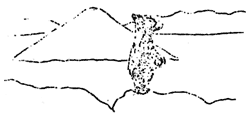|
Volume II No. 1 - July 1, 1929
Our Bears
By Earl U. Homuth
Last year our bears returned to their usual haunts around
Headquarters so late in the summer that for a time it was feared they
had left us for other regions. This year there is no question as to
their whereabouts.

Jemima (the former Jimmy), who first appeared about the 1st of June,
wanders down to the mess house each evening. She is alone this year, as
her husky cubs of last season are shifting for themselves.
A yearling cub became so intimate with the "bug crew", which has
been working on pine bark beetle eradication, that several men have had
to spend lunchless days in the forest. Lunches are now suspended from
the ends of small branches.
Another yearling has been developing the habit of begging or
demanding food from tourists entering on the Medford road. He is
reported by those coming in on this road nearly every day.
Hans, Fritz, and others of those known personally to the rangers
have been reported, so this season we will undoubtedly not miss the
interest that bears create.
The Fruiting Bodies Of The Slime Molds
By Frederick L. Wynd
In the earlier part of the season during the time when the snow is
melting in the deep woods just below the Rim, the fruiting bodies of the
slime molds may be found in great numbers on the ground and on rotten
logs. They are usually about one-half inch in diameter and are bright
orange in color which makes them very conspicuous and easily identified.
The spores are borne in great numbers in the interior of the mass.
The great group of slime molds are among the most interesting plants
in existence, and their strange life history should be more commonly
known. During certain stages they show the characteristics of animals,
and in other stages they appear as typical plants.
In the evolutionary scheme of things in which we regard the plants
and animals as having a common ancestry, we would expect to find forms
of life which are not clearly differentiated into either. The slime
molds are among these "missing links" that connect the two great classes
of life.
Identity?
By C. L. Croghan, Park Ranger
While putting things away for the winter at Anna Springs last
November, a young pine squirrel was noticed, very busily engaged in
stowing away his winter supply of pine cones. On closer observation it
was discovered that this squirrel had different markings than the
ordinary pine squirrel. It was thought possible that this could be due
to its immaturity.
This summer it was again observed working around various trees and
dwellings. The body is more slim than that of the ordinary pine
squirrel of the Castle Creek area. The coat, while of about the same
color on the back, is distinctly a more golden brown underneath. The
tail has a white tip rather than the usual black; and the fur along the
edges of the tail is of grayish color instead of brown and black.
| 
